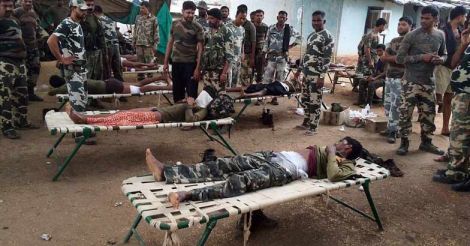The deadly Maoist ambush on Central Reserve Police Force (CRPF) contingent, which left at least 25 jawans dead in Sukma on Monday, has exposed huge gaps in intelligence gathering and combat methods of the world's largest paramilitary force. The ambush site, Sukma, is in the southern part of Chhattisgarh and is generally hilly. The semi-dry deciduous forests and large Sal trees give the insurgents a definite terrain advantage. In jungle and mountain drill, those 'firing down' are supposed to have an upper hand. Moreover, the Maoists deftly use the familiarity of the terrain to their specific advantage.
The CRPF largely relies on conventional and human intelligence inputs, which can go wrong. Also, conventional intelligence gathering, and 'thread creation' take a lot of time and painstaking groundwork. It may work in an urban environment where operatives can mingle with the crowd. But in rural and jungle settings, a stranger is easily spotted and operatives are very conspicuous. 'Deep-throat' intelligence is difficult to create unless the local foothold is good and populace takes the force into confidence. This needs long-term strategy and planning.
The highest challenge of fighting Maoists in their turf is that the CRPF uses conventional techniques of combat against a guerilla group, which employs unconventional techniques. As battle-hardened jawans say, they 'appear, fire, and disappear,' leaving a very small response window.
CRPF men travel on the road and a 'rudimentary' lookout can warn the insurgents of the exact location and strength of the contingent.
In Sukma, the CRPF now suspects a set of eyes in the air, unmanned aerial vehicles, to have tracked the movement of the personnel ahead of the ambush.
Now, the CRPF has sought foliage penetration radars (FOPEN) to track Maoist movement. At present, the CRPF's two drones are operated by the National Technical Research Organisation (NTRO) in Bhilai. Sources say this is inadequate to cover a deeply forested and highly infested state like Chhattisgarh.
Also, there is a cue to take from the strategy adopted over the years by Andhra Pradesh. The state laid roads to the most remote locations. This pushed the Maoists further into the jungles. Also, mobile towers were installed across the state, some in the most unwanted locations. Due to this, the Maoists inadvertently ended up being tracked. The Greyhounds of the Andhra Pradesh police acted in tandem with the state's actions and carried out intensive jungle combing. Due to this multi-pronged strike, Maoist action suddenly ebbed in AP. The efficacy of the action was remarkable as Maoists made a strategic withdrawal to the Kerala-Karnataka-Tamil Nadu tri-junction of the Western Ghats, near Wayanad in Kerala.
In Chhattisgarh, there are at least 200 Maoist commanders at various levels of the hierarchy and some 4,000 cadres. Added to this is the mighty Jan Militia. They are part-time Maoists who contribute largely as the 'eyes and ears' of the combatants. The Jan Militia is at least 10,000 in number. CRPF sources said the Maoists initially started seeking the support of villagers by making issue-based interventions. The propaganda machinery worked in tandem and in a reciprocal gesture, the villagers started functioning as the Jan Militia. The success of the insurgents was in the fact that they have been successful in keeping the Jan Militia active in spite of active engagement by the police and paramilitary forces.
The people, especially the youth, are lured into the militia using songs and cultural motifs, which highlight the plight of the downtrodden and showed the state in bad light.
Unlike state-sponsored terrorism, Maoism had, at some point of time at least, livelihood and subsistence issues attached to it. It was once the voice of the suppressed. The dynamics have but changed over the years and the guns have never been silent. The state should cut the manpower supply to Maoist organizations by wiping out deprivation in red-active pockets. The supply lines should be dismantled immediately. This can have a debilitating impact on Naxalism than conventional combat. The state is duty-bound to create a combat doctrine with a non-combat focus to nix the menace.

























 Image for representation only. PTI/File photo
Image for representation only. PTI/File photo